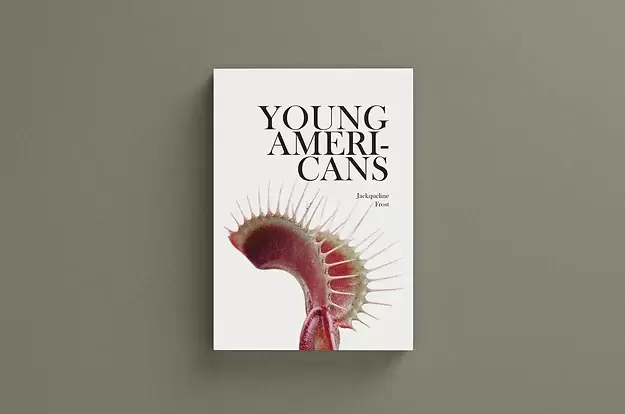Young Americans
Reviewed by Khashayar Mohammadi
|
|
Too often, when faced with poetry written from within turmoil, I am confronted with the question “was poetry the right medium for this thought to come out?” and consider strongly whether a poem was meant as a cathartic undertaking or whether its forming into poetry plays a significant role and justifies its publication. When reading Young Americans by Jackqueline Frost, I’ve become fully convinced that there are poets who not only justify, but extend the case that a poetics can be made from within turmoil.
At the advent of disaster, whether it be socio-cultural, financial or political, writing becomes a vital and urgent act, and one that can be a valuable document for further investigation. However, the document is forever at odds with the poetics of the momentary, distilling the singularity of the event into a universality beyond ethno-geographical significance, and one that can be both constructive in the machinery of empathy and destructive in the dissolution of difference that ties the incident to its vital surroundings. When reading Frost’s “Young Americans”, there are certainly strong geopolitical ties, perhaps most prominently to Louisiana and Oakland, which stand as the book’s staple ecologies where the “Young Americans” can frolic, struggle with drugs and finances, and get slaughtered at war. There is a potent and pre-meditative reconciliation with disaster in writing grounded in socio-political turmoil, one that has been at the heart of the greatest aesthetic movements in poetics in the past century. Before approaching the language and ideology of Jackqueline Frost’s “Young Americans”, the first striking feature of the poetry is its presentation. Each poem in the first half of “Young Americans” is designed for a specific frame, as if they’ve been composed and sized on a canvas before being hung in perfect frame against the white background of the page. These poem-portraits, firmly hanging and cleanly cut, are situated where the frame can be broken with much dramatic effect in outlying iterations making a loud and clear point: if you don’t “understand” the conversation, at least you become familiarized with its shape. The poems and their iterative ‘I’s and ‘We’s (perhaps representing the titular Young American(s)) are continuously defining and redefining themselves. the state itself is an entity Frost is consistently at odds with, whether under capital or heteropatriarchy. Frost’s voice is highly critical of state and statement. each poem is a microcosm of the book’s greater poetics, all of which are built upon the aesthetic gesture towards the political moment, an act that achieves something more political than any explicit poetry of struggle can achieve. in the first major chapter we read “belonging as she/ does to the enormous/ bliss of american death”. A few pages on we read “Call for a new language/ first learn from violence” and so does Frost. To speak to violence, one must first listen to violence, and considering the trauma received while listening, an explicit retort is one that can further circulate trauma into later listeners. Frost’s construction of an aesthetic gesture towards the political moment is therefore an act rooted in reclamation of power as well as one that cuts off this endless circle of trauma and violence at its root: to speak violence in its own tongue is to perpetuate violence, and that is why Form is so important to Frost’s work. Frost’s form starts from the power of the conjunctive and its incredible usefulness in conveying the poetics of mood and weather. Mood and weather (two of philosophy’s most uncharted topics) become germane to the geo-politics of Young Americans. Frost’s form isn’t something built, but the form itself is a narrative she wields: a language system clad in flamboyant paint not to make language beautiful, but to make it recognizable against the enemy: the canonical. The conjunctive and subjunctive play important roles in the traversal of the breath, something that becomes poetically more significant in the second chapter of the book, “You Have the Eyes of a Martyr”. There’s a sudden move away from the sentence and into the breath itself. We read “dear prisoner, december was/ and serpent’s milk/ is also” [slashes included in original]. Whereas, in the book’s first half, the breath was dictated by white space and space between words, “You Have the Eyes of a Martyr” forces breaks with the use of the slash, even taking the place of paragraph breaks sometimes. the slash then itself creates separate sub junctures in the poems’ conjunctures. We later read “/there is a part of you/ you grieve/ but I do not/ and so am heretical” where the written word glides between speech and its breath, and writing and its subsets within speech. The slash violently cuts, violently breaks, cleaves and separates. the slash bleeds the poems into an incongruous reading experience. when reading “You Have the Eyes of a Martyr”, the reader needs to break down every poem and rebuild it, forming any thought about it from scratch. In the end, after reading Young Americans, one comes away with an important lesson: if a poetry is translucent, it means it is ideologically repetitive. Only an opaque poetics can create new discourse in a world on the verge of destruction, something that Jackqueline Frost has been able to achieve with incisive wit, socio-political observation and layer upon layer of style and form creating something truly magnificent. Khashayar “Kess” Mohammadi is an Iranian-born Toronto-based writer and translator.
|


